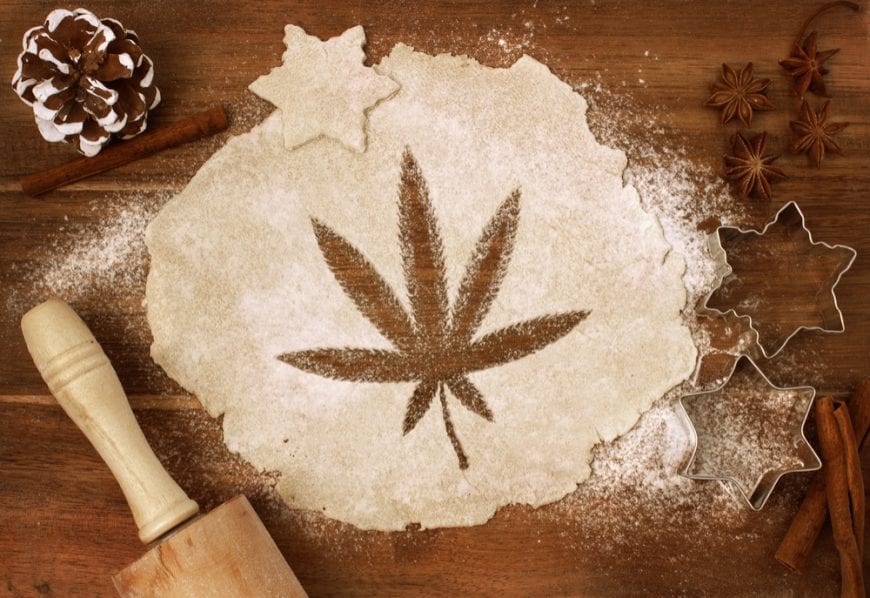For best baking results, you should use decarboxylation to infuse your bud into a butter or cooking oil. No one wants bits of flower in their cookies. But why do you decarboxylate weed?
You decarboxylate weed because Decarboxylation is the key to activating the cannabinoids that will bind to the receptors in your body, and bring all of that good healing. Sure, if you eat raw bud, stomach acid will convert some of that CBDa to CBD and THCa to THC etc… but not nearly enough. There is some skill involved with decarboxylating so that you end up with a smooth product that is full activated.
What is Decarboxylation?
The cannabinoid acid pre-cursers (THCa, CBDa, CBGa, etc) in raw cannabis certainly have medicinal benefits – which is why cannabis juicing has become an important healing trend. If you’re looking to access the medicinal benefit of the primary cannabinoids (THC and CBD), however, decarboxylation has to come first.
Decarboxylation turns raw cannabinoids into the psychoactive cannabinoids. It slightly alters their chemistry, which means that they also provide different medicinal benefits. This is a chemical reaction that removes a carboxyl group from the pre-curser compounds and releases carbon dioxide.

How Do You Decarboxylate Weed to Activate THC?
Like baking a cake, decarboxylation requires heat and time. This can be achieved in a few different ways, and the early stages of drying and curing cannabis actually do begin the process. Small amounts of THCa will transform into THC during the drying and curing process.
However, to complete decarboxylation, more intense heats are required. When you smoke cannabis, you are actually completing this process and allowing the compounds to drop that carboxyl group and become activated. This process also allows you to effectively and easily absorb the cannabinoids through your lungs and then achieve medicinal benefit as these activated cannabinoids bind to CB1 and CB2 receptors.
Cooking cannabis requires a bit more attention. By heating cannabis up to too high a temperature, you may burn off the terpenes and produce a less desirable smell and flavour. If you purchase a new cannabis oil, it will already be decarboxylated. If you want to cook with that oil, here’s where care must be taken.
Temperatures above 300 degrees F are too high. You want to stick in the 220-240F range to ensure you preserve desirable qualities and compounds. Keep baking temperatures at about 240F to protect all of the wonderful qualities of the cannabis oil. This means it will take longer to bake, but as with all things in life, the good things take time.

How to Perform Decarboxylation at Home
If you are starting with dry flower, then you will need to decarboxylate before cooking/baking.
- First, you need a clean baking sheet and parchment paper.
- Line the baking sheet with the paper, and preheat your oven to 220-235 degrees Fahrenheit. The temperature will depend on the model of oven you have – if your oven runs hotter than usual, keep that in mind and choose the lower temperature in the spectrum.
- Grind your cannabis nice and small so that you can spread it out evenly on the parchment lined baking sheet.
- You’ll want to cook it then for around 30-45 minutes.
- You’ll need about 1 oz of cannabis for 1 pound of butter.
Also – The Slow Cooker Method
If you’d rather not use your oven or you don’t have a baking sheet, slow cookers also work.
You can complete decarboxylation in the slow cooker if you add a solvent such as butter or any cooking oil. This method is great if you’re looking for an infusion with which to bake edibles.
- On low setting, slow cook for 4 hours.
Easy peasy, right?
What to Make With Decarboxylated Cannabis
Now that you know why you decarboxylate weed, you’ll want to know what to do with your decarboxylated cannabis.
The options are abundant. You can make:
- Butter
- Any Medibles
- Salve
- Coconut Oil
- Olive Oil
- Cannabis Pills (literally decarbed cannabis in a pill capsule)
- Ice Cream
- Salad
Now you know the process, you will be able to perfectly perform decarboxylation for your cannabis medibles. A wide world of medication is now available to you. Have a favourite recipe? Share it below, and let your friends know!





